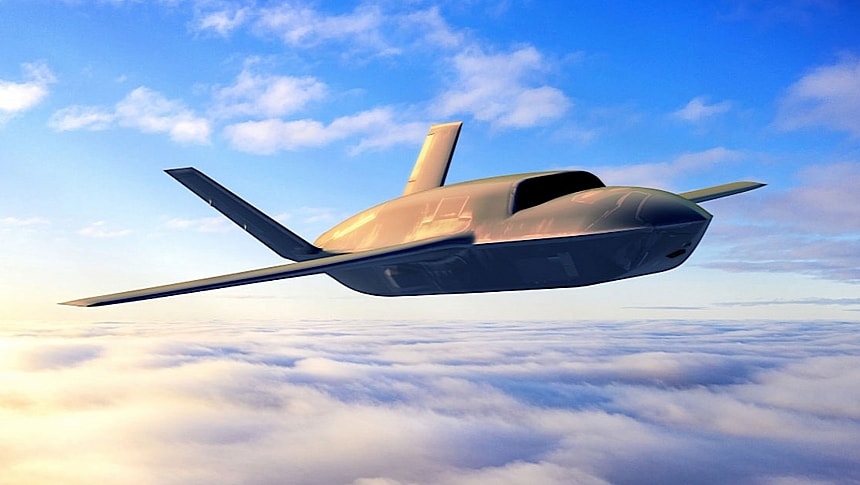The modern-day battlefields are flooded with fighter jets and drones. Each of the two families of aircraft has a specific role to fulfill, from intelligence gathering to actual combat, and in the vast majority of cases, military aircraft and drones don't really mix. But that will change in the not-so-distant future.
For a while now the militaries of the world have been working on a concept called Collaborative Combat Aircraft (CCA). At least that's the name used by the U.S. Air Force, with others calling the concept loyal wingman and even support drone.
CCA is an umbrella term for a kind of drone packed to the teeth with both sensors and weapons that could fly in support of fighter jets and bombers, not only to assist them with intelligence but also aid them in combat operations – something the USAF calls force multiplier.
As a general rule these drones need to be relatively cheap to make and operate and they must be easy to integrate with current military operations. Several designs are currently on the table, but the USAF seems to have settled on a drone made by defense contractor General Atomics.
The company announced last week it had been selected by the USAF Life Cycle Management Center (AFLCMC) to "build production representative flight test articles of the CCA."
The full details on the drones are not known at the moment, but we do know they will be based on tech currently being researched as part of the XQ-67A program.
The XQ-67A is a drone based on the XQ-58A Valkyrie produced by defense contractor Kratos. We last heard about it back in February, when General Atomics announced it had conducted the maiden flight of the hardware. It was followed by an extra two flights, with the drone packing no weapons, but plenty of hardware to help it gather data.
The drone is meant to be unlike anything before it, "the first aircraft type built and flown using a common core chassis." What that means is it will be suitable for adaption for a variety of roles using a common platform – something the automotive industry, for instance, has been doing for ages.
Its capabilities are not entirely known, but we do know what the Kratos drone is capable of. And that is speeds of 652 mph (1,050 kph), flight distances of 2,449 miles (3,941 km) miles, and the ability to carry an assortment of weapons, including Joint Direct Attack Munition (JDAM) and small-diameter bombs.
General Atomics will now move to design, build, and flight test a new CCA, but it does not say when we will be able to witness the first prototypes flying. In parallel the company will run autonomy and mission systems tests on the MQ-20 Avenger to accelerate the development of the support drone.
CCA is an umbrella term for a kind of drone packed to the teeth with both sensors and weapons that could fly in support of fighter jets and bombers, not only to assist them with intelligence but also aid them in combat operations – something the USAF calls force multiplier.
As a general rule these drones need to be relatively cheap to make and operate and they must be easy to integrate with current military operations. Several designs are currently on the table, but the USAF seems to have settled on a drone made by defense contractor General Atomics.
The company announced last week it had been selected by the USAF Life Cycle Management Center (AFLCMC) to "build production representative flight test articles of the CCA."
The full details on the drones are not known at the moment, but we do know they will be based on tech currently being researched as part of the XQ-67A program.
The XQ-67A is a drone based on the XQ-58A Valkyrie produced by defense contractor Kratos. We last heard about it back in February, when General Atomics announced it had conducted the maiden flight of the hardware. It was followed by an extra two flights, with the drone packing no weapons, but plenty of hardware to help it gather data.
The drone is meant to be unlike anything before it, "the first aircraft type built and flown using a common core chassis." What that means is it will be suitable for adaption for a variety of roles using a common platform – something the automotive industry, for instance, has been doing for ages.
Its capabilities are not entirely known, but we do know what the Kratos drone is capable of. And that is speeds of 652 mph (1,050 kph), flight distances of 2,449 miles (3,941 km) miles, and the ability to carry an assortment of weapons, including Joint Direct Attack Munition (JDAM) and small-diameter bombs.
General Atomics will now move to design, build, and flight test a new CCA, but it does not say when we will be able to witness the first prototypes flying. In parallel the company will run autonomy and mission systems tests on the MQ-20 Avenger to accelerate the development of the support drone.






